Left Hand Classical Guitar Technique
Please remember that to have a good teacher is the most important thing to acheive good results in playing classical guitar, let's take a look at the left hand.
Andres Segovia's scales will greatly improve your left hand technique:
you can find more details
about Segovia's scales at this link
https://danielemagli.blogspot.com/2011/11/andres-segovia-scales-for-classical.html
Talking about sound emission there are two tasks depending on the left hand:
1) Sound frequency choice and grooming
2) Sound sustaining and processing
That's why the sound seems to be a three parted event
1) Grooming (left hand)
2) Emission (right hand)
3) Sustaining and processing (left hand)
I'll write about five topics:
1) left hand posture and angle
2) guitar barre
3) vibrato
4) mixed mouvements
5) position changes
Left hand posture and angle
As Angelo Gilardino wrote there are two points in the left hand to pay more attention for: the weaker finger (the little finger) and the overwork for the index finger in fact the finger has to perform the barré as well. You'll have to point the left hand to get the little finger phalanx perpendicular to the strings. The index finger will form a barré even pressing only one string. Keep in mind that the index finger is just like a fan ready to be opened.
The left hand thumb is opposite to the others fingers corresponding to the index finger or the middle finger depending on what we are going to do.
Whenever your fingers play on the 5th or 6th string the thumb will have to go down to the lower zone on the back of the fretboard if you have little hands but whenever your fingers play on the 1st or 2nd string the thumb will have to go up to the higher zone on the back of the fretboard if you have big hands.
Barré
Barré is a French word and it's used when a finger push on two or more strings at the same time. The strings contact happen using the left side of the index, it's to say almost the edge.
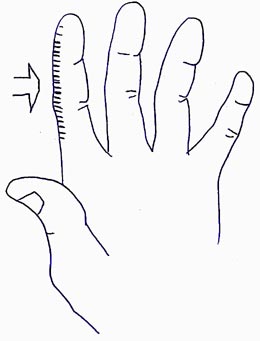
Index finger area pushing for barré
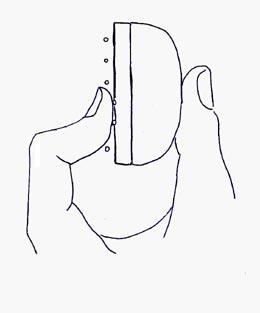
Phalanx barré position
Sustaining and processing : vibrato
You can elaborate one sound after playing it using three kinds of vibrato:
1) increasing a lot the string pressure;
2) parallel to string vibrato : moving your finger from right to left quickly or slowly;
3) perpendicular vibrato : vibrato perpendicular to string, moving your left hand finger up and down perpendicular to the string.
It's really recommended to practice a lot with Segovia's Scales
Left Hand finger's mouvements
It's very important for any classical guitarist to study left hand finger's mouvent: they happen touching strings but not touching them too when fingers shift.
As for the right hand mouvements have to be short but the fingers joints mouvment ability should be the more wide as possible.
Here are some tips on the most frequent cases :
1) Position change
You can do it mantaining contact on the strings, paying attention to unpleasant sounds or you can do it releaving contact on strings completely.
2) String shifting
Wrist must be steady. I suggest you to imagine the correct way for the finger wich has to shift.
3) Miscellaneous mouvments (position change and string shifting)
I suggest you to bend your mouvment. The bend have to present its higher point at half way between the starting point and ending point.
4) Fingers Dilation
It's easier to execute a fingers dilation pushing your fingers to spread as a task coming from the bottom of your fingers instead of your fingers tips. See the following image
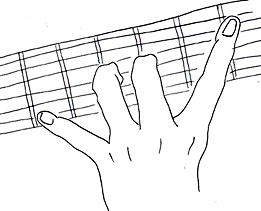
5) Fingers opposition
You have to try to practice your fingers elasticity. In case of pushing the sixth string using a short little finger, it will be helpfull to use the wrist and to skew the left hand leftward. See the following image
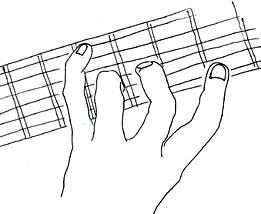
6) Fingers Contraction
It compels the fingers to stay in a narrow space. Generally it is better to mantain the little finger at the bottom and the index on top. See the following image
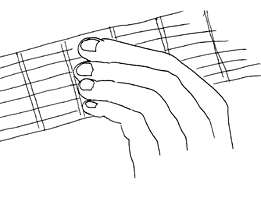
This is an easy arpeggio composed by Daniele Magli entitled 'Twilight' and it's usefull to understand the fingerboard and the glissato technique. You can download the free .pdf score and follow the video.
Twilight
This is a guitar legato technique
piece composed and played by
Daniele Magli with a combination of legato slurs and pull off.
Lost in Space
Blue Galaxy is composed and
played by Daniele Magli
for practicing with guitar stretch technique.
Blue Galaxy
This piece called 'Summer Love' composed by Daniele Magli is a combination of different arpeggios and scales. It's rather difficoult for the left hand.
Summer Love
'Parallel Universe' composed by Daniele Magli is the most difficoult piece to be played because of its combination of different techniques, rythms and arpeggios. The sixth string is on D tuned. It is very funny to play this piece once you're at a advanced level.
Parallel Universe
How to avoid noise when shifting
Avoiding noises when shifting is a virtuosity :
1) When changing from a chord to another one it is necessery to have a well trained left hand and it should be spread out more than what you expected. You can acheive it playing really slowly even using just the left hand and spreading out your fingers.
2) It's necessary to leave the chord moving on top perpendicularly referring to your strings. (this is really hard to do quickly because we unconsciously would like to shorten the room moving in the strings direction)
3) When changing the same chord passing through a fret to another one you can use the fingers positioned on the nylon strings to let them slide soaring the fingers on the bass strings. It is possible to have a try of this on Etude n.1 by Heitor Villa-Lobos.
This video contains Segovia's Scales, Finger nails care and other tips by Daniele Magli
All free .pdf scores about Daniele Magli music and tips HERE
Check out the Daniele Magli's classical guitar blog at https://danielemagli.blogspot.com
I will add further details as soon as possible.
|
|
|
|